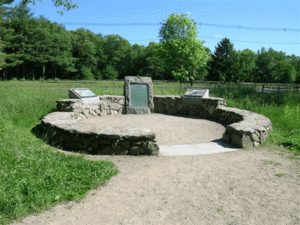Frequently Asked Questions about the Midnight Ride of Paul Revere
What was the name of Paul Revere’s horse?
 A better question would be: “What was the name of the horse Revere rode?” because there is no evidence that Revere owned a horse at the time he made his famous ride. At some point, Paul Revere likely owned a horse or he certainly had ready access to horses in order to become the experienced rider that he was. If he had owned a horse in April 1775, it is unlikely he would have tried to bring it with him when he was rowed across the Charles River to Charlestown.
A better question would be: “What was the name of the horse Revere rode?” because there is no evidence that Revere owned a horse at the time he made his famous ride. At some point, Paul Revere likely owned a horse or he certainly had ready access to horses in order to become the experienced rider that he was. If he had owned a horse in April 1775, it is unlikely he would have tried to bring it with him when he was rowed across the Charles River to Charlestown.
Revere left several accounts of his “Midnight Ride,” and although he states that he borrowed the horse from John Larkin, neither he nor anyone else takes much notice of the horse, or refers to it by name. Revere calls it simply “a very good horse.” In the years since 1775 many names have been attached to the animal, the most exotic probably being Scheherazade. The only name for which there is any evidence, however, is Brown Beauty. The following excerpt is taken from a genealogy of the Larkin family, published in 1930.
Samuel (Larkin) … born Oct. 22, 1701; died Oct. 8, 1784, aged 83; he was a chairmaker, then a fisherman and had horses and a stable. He was the owner of “Brown Beauty,” the mare of Paul Revere’s Ride made famous by the Longfellow poem. The mare was loaned at the request of Samuel’s son, deacon John Larkin, and was never returned to Larkin.
According to this source, the famous horse was owned not by John Larkin, but by his father – if true, this would mean that not only did Revere ride a borrowed horse, but a borrowed, borrowed horse. Its name is difficult to prove in the absence of corroborating evidence. John Larkin’s estate inventory, dated 1808, lists only one horse, unnamed, valued at sixty dollars. It reveals, however, that Larkin was a wealthy man, with possessions valued at over $86,000, including “Plate” (silver and gold items), houses, pastures, and other real estate in Charlestown, part of a farm in Medford, bank shares, and notes (for money lent at interest). As a friend of the patriot cause in Charlestown, it seems natural that the Sons of Liberty would have depended on someone in Larkin’s position to provide an expensive item like a horse if the occasion demanded. The fact that one horse listed in his inventory is unnamed, while not conclusive, does suggest that the Larkin family, like most people at the time, did not name their horses. Thus, it appears that “Revere’s horse” will forever remain anonymous.
Note: John Larkin is often referred to as “Deacon John Larkin” in modern narratives of Revere’s Ride — and even by Revere himself in his 1798 letter to Jeremy Belknap. In fact, however, John Larkin was made a deacon of his church long after the Revolutionary War ended. In 1775 he was, simply, John Larkin.
Did Revere finish his midnight ride?
We know that Paul Revere never arrived in Concord after being captured on the way there. It is also known that a third man in Revere’s party, Dr. Samuel Prescott, who joined Revere and Dawes outside of Lexington, did alarm the militia in Concord. This sometimes leads to an argument that Revere never “finished” his ride.
We have to consider what Revere and Dawes intended to accomplish when they set out from Boston. While existing evidence (primarily Revere’s own accounts of his activities that night) is somewhat vague or contradictory on certain points, the main outline of Revere’s (and Dawes’s) mission seems clear enough. Both men’s primary objective was to contact Samuel Adams and John Hancock in Lexington. It appeared they were given a fairly specific (probably written) message to deliver to the patriot leaders. In addition, the two riders were to “alarm” the countryside. A third objective was almost certainly to continue on to Concord to verify that the “Colony Stores” — provisions, powder, ammunition, and cannon for the Massachusetts militia — were safely dispersed and hidden.
As is clear from Revere’s own accounts, patriot leader Dr. Joseph Warren, who dispatched both Revere and Dawes by separate routes into the countryside, was unsure of the British troops’ objective. Revere quotes Warren in his 1775 deposition “it was supposed, that they were going to Lexington, by way of Cambridge River, to take them [Hancock and Adams], or go to Concord, to distroy the Colony Stores.” The fact that they might be halted at any point was assumed by both men, as they were well aware that British officers were patrolling the roads that night for the specific purpose of intercepting messengers like themselves.
The alarm system devised by the patriots, and set in motion by Revere and Dawes, was specifically designed to insure that the capture of any one rider would not prevent the alarm from being sounded. The mission was too important to leave to one rider alone, even one as experienced and trustworthy as Paul Revere.
For answers to more of your Midnight Ride questions listen to the “Midnight Ride Q&A with Robert and Adrienne” episode of Revere House Radio or check out What Was the Name of Paul Revere’s Horse? Twenty Questions About Paul Revere- Asked and Answered by Partrick Leehey available through our gift shop, both online and in person.
